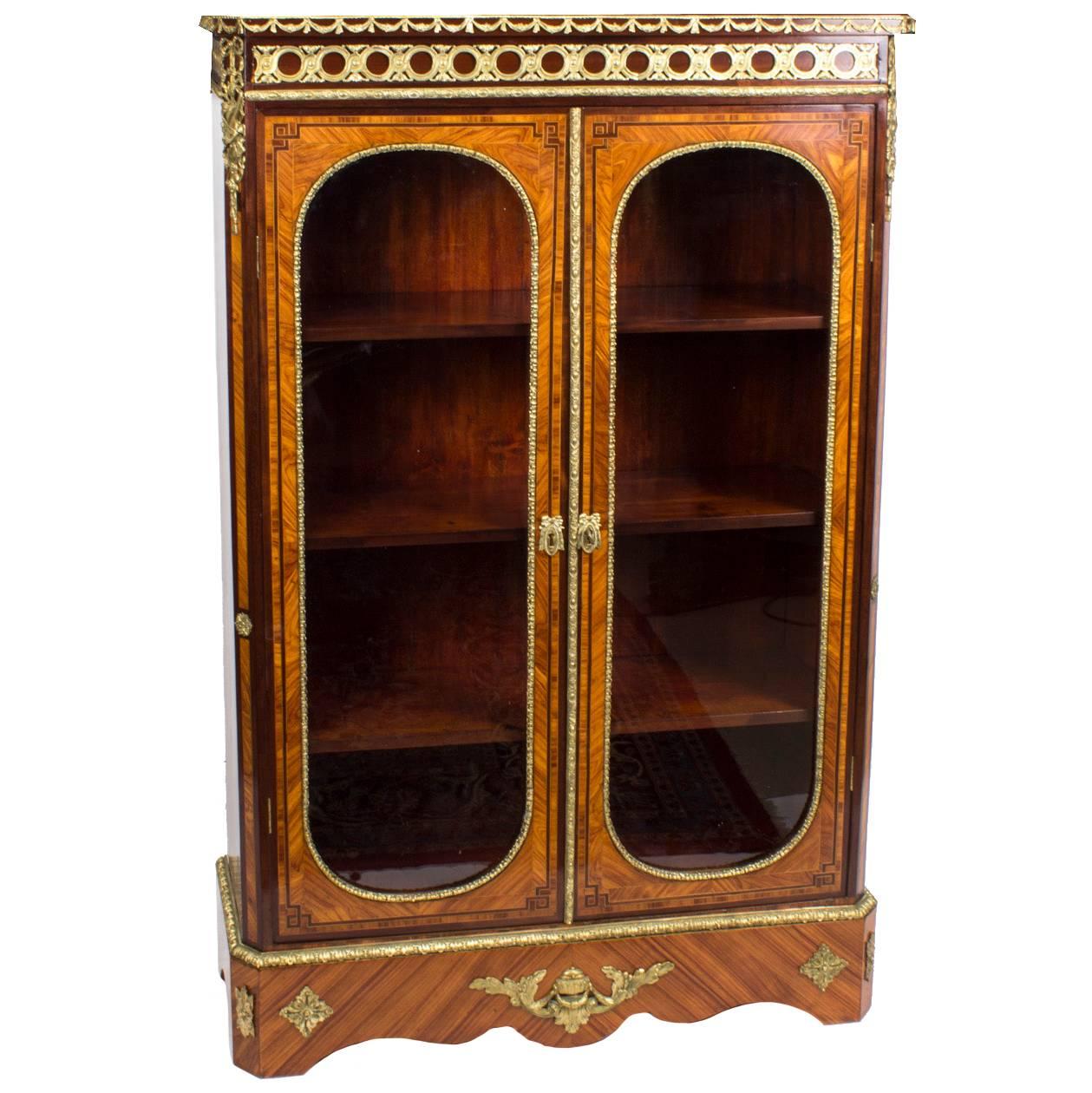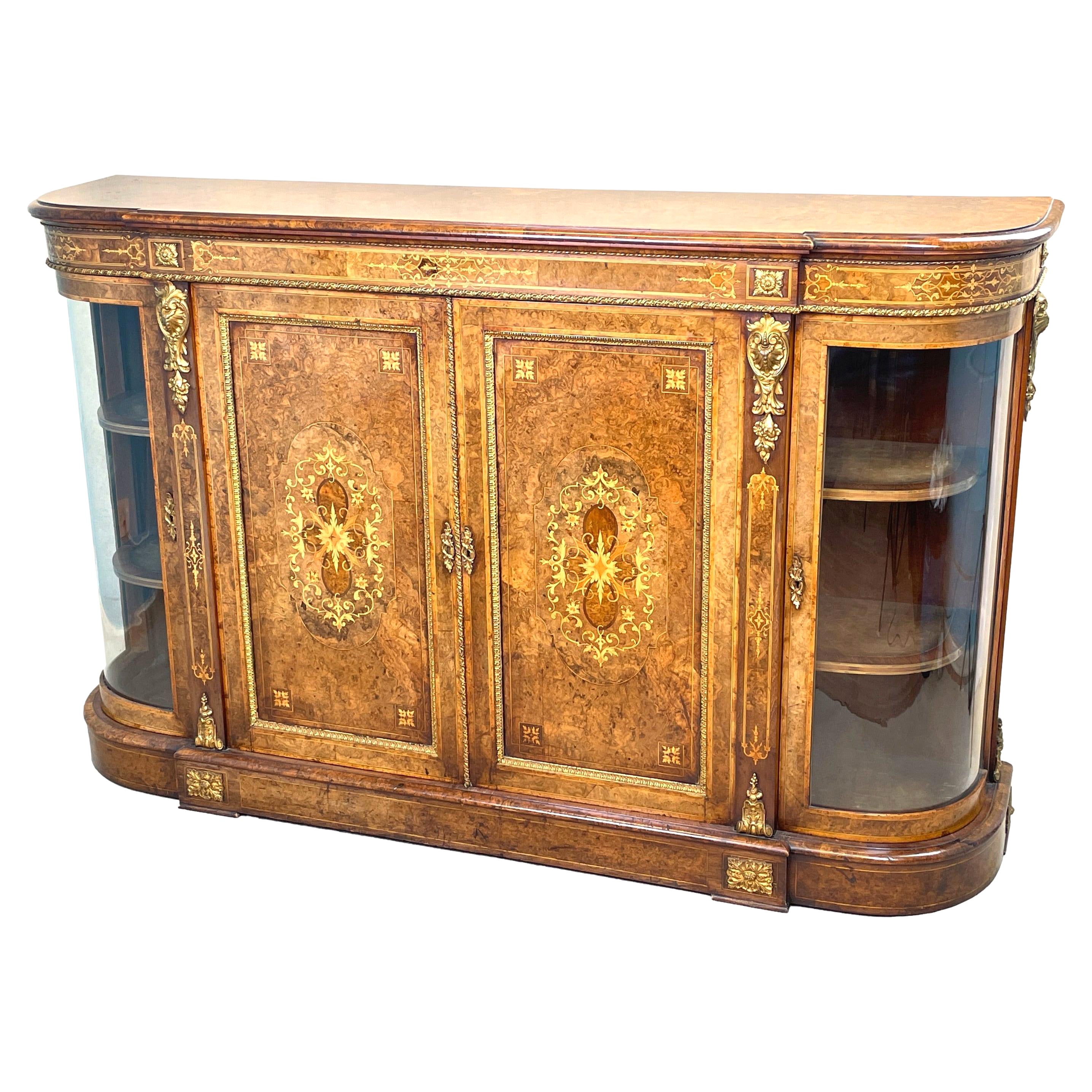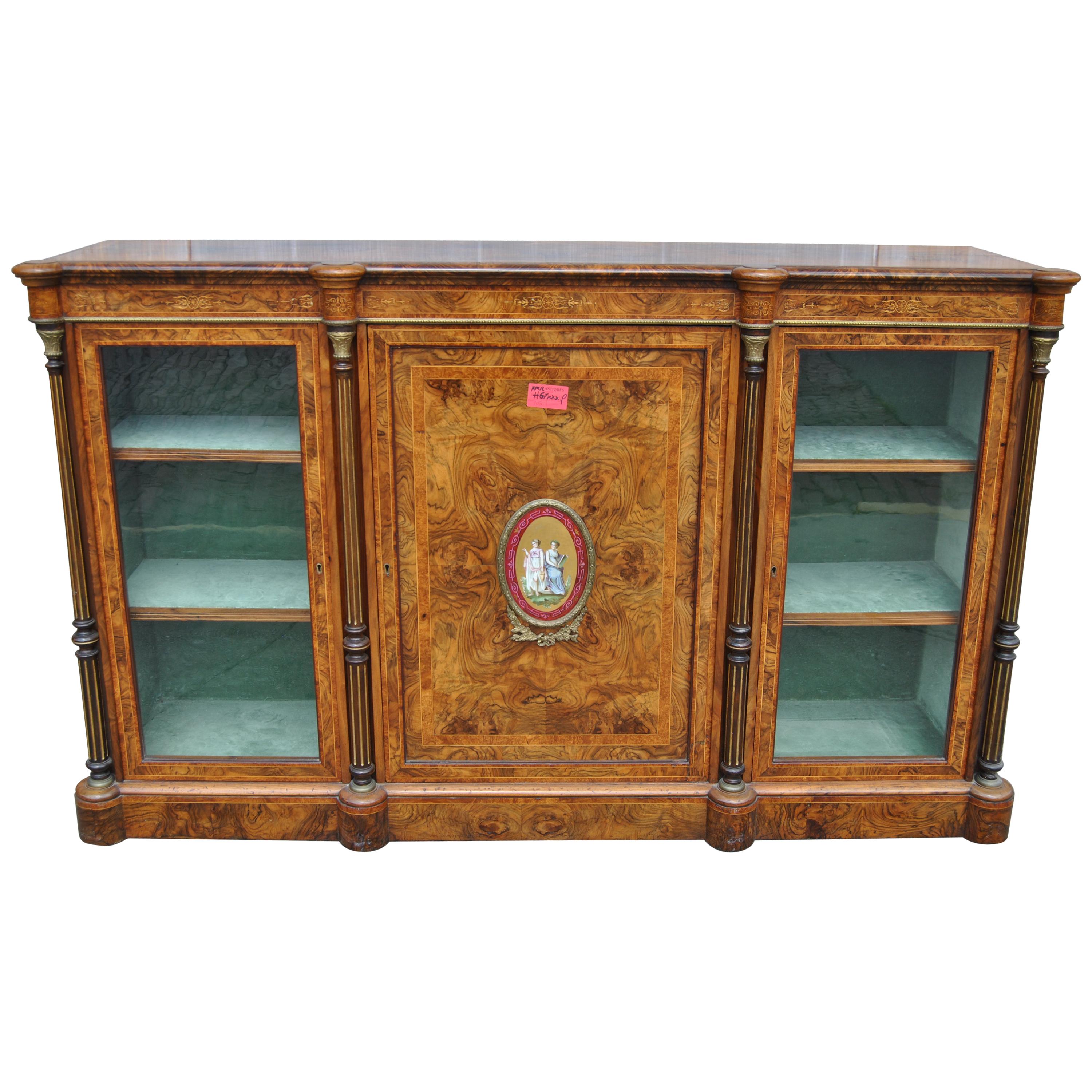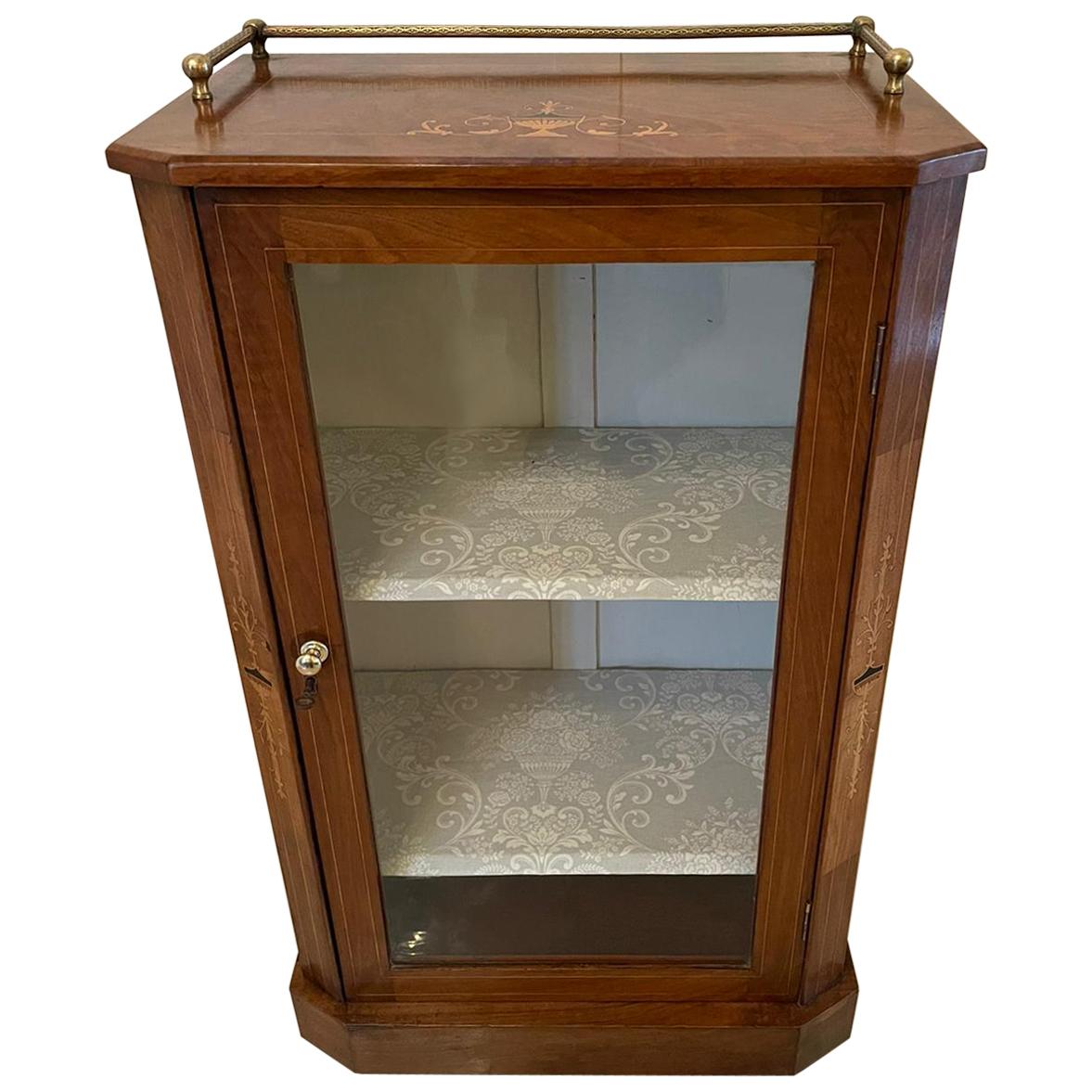Items Similar to Victorian Burr Walnut Sevres Plaque Mirror Back Credenza Cabinet, 19th Century
Want more images or videos?
Request additional images or videos from the seller
1 of 21
Victorian Burr Walnut Sevres Plaque Mirror Back Credenza Cabinet, 19th Century
About the Item
This is a monumental fine and rare antique Victorian burr walnut and amboyna, Sevres porcelain and ormolu-mounted breakfront mirror backed credenza, circa 1860 in date.
The well figured burr walnut top with perfectly matched veneers above a rectangular door centred with an oval Sevres porcelain plaque superbly painted with a Watteauesque courting couple on a bleu celeste ground with gilt highlights, flanked by a pair of glazed doors divided by acanthus grasped fluted ormolu-mounted columns.
The credenza with boxwood line inlaid decoration, amboyna panels, striking ormolu mounts and raised on a plinth base. Amazingly the interior of the credenza is lined with the original sumptuous burgundy leather. The large mirror back features a gilt mask on top and th mirror is framed by a pair of Corinthian Columns with beaded egg and dart moulding, the out-set corners are decorated with acanthus leaves.
Complete with working locks and keys.
This is a stunning piece which is sure to attract a lot of attention wheever placed.
Condition:
In excellent condition having been beautifully cleaned, polished and waxed, and the interior relined, in our workshops, please see photos for confirmation.
Dimensions in cm:
Height 295 x width 187 x depth 48
Dimensions in inches:
Height 116.1 x width 73.6 x depth 18.9
Burr walnut refers to the swirling figure present in nearly all walnut when cut and polished, and especially in the wood taken from the base of the tree where it joins the roots. However the true burr is a rare growth on the tree where hundreds of tiny branches have started to grow. Burr walnut produces some of the most complex and beautiful figuring you can find.
Amboyna
is a type of wood which has its origins in Indonesia (the preferred veneer comes particularly from the Andaman Islands). The grain texture is one of the most seldom and exclusive on earth.
The burls are often very small, which is why the sheets of veneer come in small dimensions. The colours range from deep yellowish-orange to dark red.
After finishing the surface, the grain texture of amboyna wood has a depth and richness unmatched in other textured woods.
Sevres Porcelain traces its roots in France to early craftsmen who had small manufacturing operations in such places as Lille, Rouen. St. Cloud, and most notably Chantilly. It is from Chantilly that a cadre of workers migrated to the Chateau de Vincennes near Paris to form a larger porcelain manufactory in 1738. French King Louis XV, perhaps inspired by his rumoured relationship with mistress Madame de Pompadour, took an intense interest in porcelain and moved the operation in 1756 to even larger quarters in the Paris suburb of Sevres. Sevres was also conveniently near the home of Madame de Pompadour and the King's own Palace at Versailles.
From the outset the king's clear aim was to produce Sevres Porcelain that surpassed the established Saxony works of Meissen and Dresden. Though the French lacked an ample supply of kaolin, a required ingredient for hard-paste porcelain (pate dure), their soft-paste porcelain (pate tendre) was fired at a lower temperature and was thus compatible with a wider variety of colours and glazes that in many cases were also richer and more vivid. Unglazed white Sevres Porcelain "biscuit" figurines were also a great success. However, soft-paste Sevres Porcelain was more easily broken. Therefore, early pieces of Sevres Porcelain that remain intact have become rare indeed.
The Sevres Porcelain manufactory always seemed to be in dire financial straits despite the incredibly fine works it produced. In fact, the king's insistence that only the finest items be created may have contributed to the difficulties. Only a limited number of European nobility could afford the extravagant prices demanded for such works. King Louis XV and eventually his heir, the ill-fated Louis XVI, were obliged to invest heavily in the enterprise. Ultimately, the Sevres Porcelain Factory produced items under the name of "Royal" and thus the well-known Sevres mark was born. King Louis XV even mandated laws that severely restricted other porcelain production in France so as to retain a near monopoly for his Sevres Porcelain. The king even willingly became chief salesman for the finest of his products, hosting an annual New Year's Day showing for French nobility in his private quarters at Versailles. He eagerly circulated among potential buyers, pitching the merits of ownership and policing the occasional light-fingered guest.
Sevres Porcelain may have indeed given the makers of Meissen and Dresden a run for their money by the end of the 18th century but for the French Revolution. By 1800, the Sevres Porcelain Works were practically out of business due to the economic devastation of the new French Republic.
About the time when Napoleon Bonaparte named himself Emperor of France (1804), a new director was named for the Sevres Porcelain Manufactory. Alexandre Brongniart, highly educated in many fields, resurrected Sevres Porcelain. Soft-paste porcelain was eliminated altogether thanks to the earlier discovery of kaolin near Limoges. For four decades until his death, Brongniart presided over monumental progress for Sevres Porcelain, catering not only to Napoleon himself, but at last to include the more financially profitable mid-priced market in the emerging middle class.
Ormolu - (from French 'or moulu', signifying ground or pounded gold) is an 18th century English term for applying finely ground, high-carat gold in a mercury amalgam to an object of bronze.The mercury is driven off in a kiln leaving behind a gold-colored veneer known as 'gilt bronze'.
The manufacture of true ormolu employs a process known as mercury-gilding or fire-gilding, in which a solution of nitrate of mercury is applied to a piece of copper, brass, or bronze, followed by the application of an amalgam of gold and mercury. The item was then exposed to extreme heat until the mercury burned off and the gold remained, adhered to the metal object.
After circa 1830 because legislation had outlawed the use of mercury other techniques were used instead. Electroplating is the most common modern technique. Ormolu techniques are essentially the same as those used on silver, to produce silver-gilt.
- Dimensions:Height: 116.15 in (295 cm)Width: 73.63 in (187 cm)Depth: 18.9 in (48 cm)
- Style:Victorian (Of the Period)
- Materials and Techniques:
- Place of Origin:
- Period:
- Date of Manufacture:circa 1860
- Condition:
- Seller Location:London, GB
- Reference Number:
About the Seller
5.0
Platinum Seller
These expertly vetted sellers are 1stDibs' most experienced sellers and are rated highest by our customers.
Established in 1983
1stDibs seller since 2012
1,204 sales on 1stDibs
Typical response time: 1 hour
Associations
LAPADA - The Association of Arts & Antiques Dealers
- ShippingRetrieving quote...Ships From: London, United Kingdom
- Return PolicyA return for this item may be initiated within 14 days of delivery.
More From This SellerView All
- Antique Victorian Burr Walnut Credenza Sèvres Plaques, 19th CenturyLocated in London, GBThis is a superb antique Victorian burr walnut and ebonized Sèvres Porcelain and ormolu-mounted line inlaid breakfront credenza, circa 1860 in date. It has a striking central panele...Category
Antique 1860s English Victorian Sideboards
MaterialsOrmolu
- 19th Century Victorian Burr Walnut Low Display CabinetLocated in London, GBThis is a beautiful Victorian burr walnut and tulipwood double door low display cabinet, circa 1860 in date. It has been accomplished in the very ...Category
Antique 1860s English Victorian Cabinets
MaterialsWalnut
- Antique Victorian Satinwood & Inlaid Bedside Cabinet, 19th CenturyLocated in London, GBThis is a splendid antique Victorian satinwood bedside cabinet, circa 1880 in date. This superb antique cabinet features attractive marquetry decoration. The bedside cabinet has a ...Category
Antique 1880s English Victorian Cabinets
MaterialsSatinwood
- Antique Victorian Satinwood Bowfront Bedside Cabinet, 19th CenturyLocated in London, GBA beautiful antique Victorian bowfront satinwood bedside cabinet, circa 1880 in date. This superb antique cabinet features attractive ebony and boxwood inlaid decoration. The cabinet has a useful drawer above a cupboard with a central shelf and is raised on elegant square tapering legs. Condition: This antique Victorian bedside cabinet...Category
Antique 1880s English Victorian Cabinets
MaterialsSatinwood
- Antique Victorian Serpentine Burr Walnut Marquetry Credenza 19th CLocated in London, GBThis is an exceptional quality antique Victorian ormolu mounted burr walnut and marquetry inlaid serpentine credenza, circa 1870 in date. The entire piece highlights the unique a...Category
Antique 1870s English Victorian Credenzas
MaterialsOrmolu
- Antique Victorian Burr Walnut and Marquetry Serpentine Credenza, 19th CenturyLocated in London, GBThis is a superb antique Victorian ormolu mounted burr walnut and floral marquetry inlaid credenza, circa 1860 in date. Oozing sophistication and charm, this credenza is the absolut...Category
Antique 1860s English Victorian Credenzas
MaterialsOrmolu
You May Also Like
- 19th Century Burr Walnut CredenzaLocated in Martlesham, GBA fabulous quality 19th century burr walnut credenza, the shaped moulded top with satinwood crossbanding, above a gilt metal stiff leaf frieze and a central glazed and shaped cabinet...Category
Antique 1860s British Early Victorian Cabinets
MaterialsWalnut
- Victorian Burr Walnut Credenza CabinetLocated in Bedfordshire, GBAn exhibition quality mid 19th century burr walnut Credenza, or side cabinet, of good bold proportion Having superbly figured top over two panelled Central doors, flanked by bowed...Category
Antique Mid-19th Century English High Victorian Credenzas
MaterialsWalnut
- 19th Century English Walnut and Burr Walnut Credenza / Server / Display CabinetLocated in Savannah, GAThis is a walnut credenza / server / display cabinet made in England, circa 1860. The entirety of the piece is done in walnut and an incredible, highly figured cut of Kashmir walnut ...Category
Antique 1860s English Victorian Credenzas
MaterialsWalnut, Burl
- Antique 19th Century Victorian Burr Walnut Inlaid Music CabinetLocated in Suffolk, GBQuality 19th century antique Victorian burr walnut inlaid music cabinet having an appealing original brass gallery, a beautiful quality burr walnu...Category
Antique 19th Century English Victorian Cabinets
MaterialsWalnut
- Antique English 19th Century Victorian Burr Walnut Dentist's Collector's CabinetLocated in Glasgow, GBA super Victorian figured walnut dentist’s cabinet attributed to ‘The Dental Manufacturing Co. Ltd’ . The top with an arched back and three quarter moulded gallery with turned finial...Category
Antique Late 19th Century English Victorian Cabinets
MaterialsMarble, Metal
- 19th Century Antique Victorian Mirrored Carved Walnut Credenza/SideboardLocated in Suffolk, GBAn outstanding 19th century Victorian antique carved mirrored walnut credenza with a magnificent carved solid walnut mirror back and spectacular ...Category
Antique 1860s English Victorian Credenzas
MaterialsMirror, Walnut
Recently Viewed
View AllMore Ways To Browse
Type Case
Flute Case
Numbered Pieces
Gold Numbered Pieces
Fluted Storage
Antique Mirror Cabinets
Antique Mirrored Cabinet
Antique Mirror Cabinet
Walnut Large Cabinet
Antique Cabinet With Mirror
Walnut Cabinet Pair
Mirrored And Brass Cabinets
Brass Mirrored Cabinet
Business Case
Cabinet Mirrored Interior
England Small Cabinet
French Mirrored Cabinet
Mirrored Case Piece





